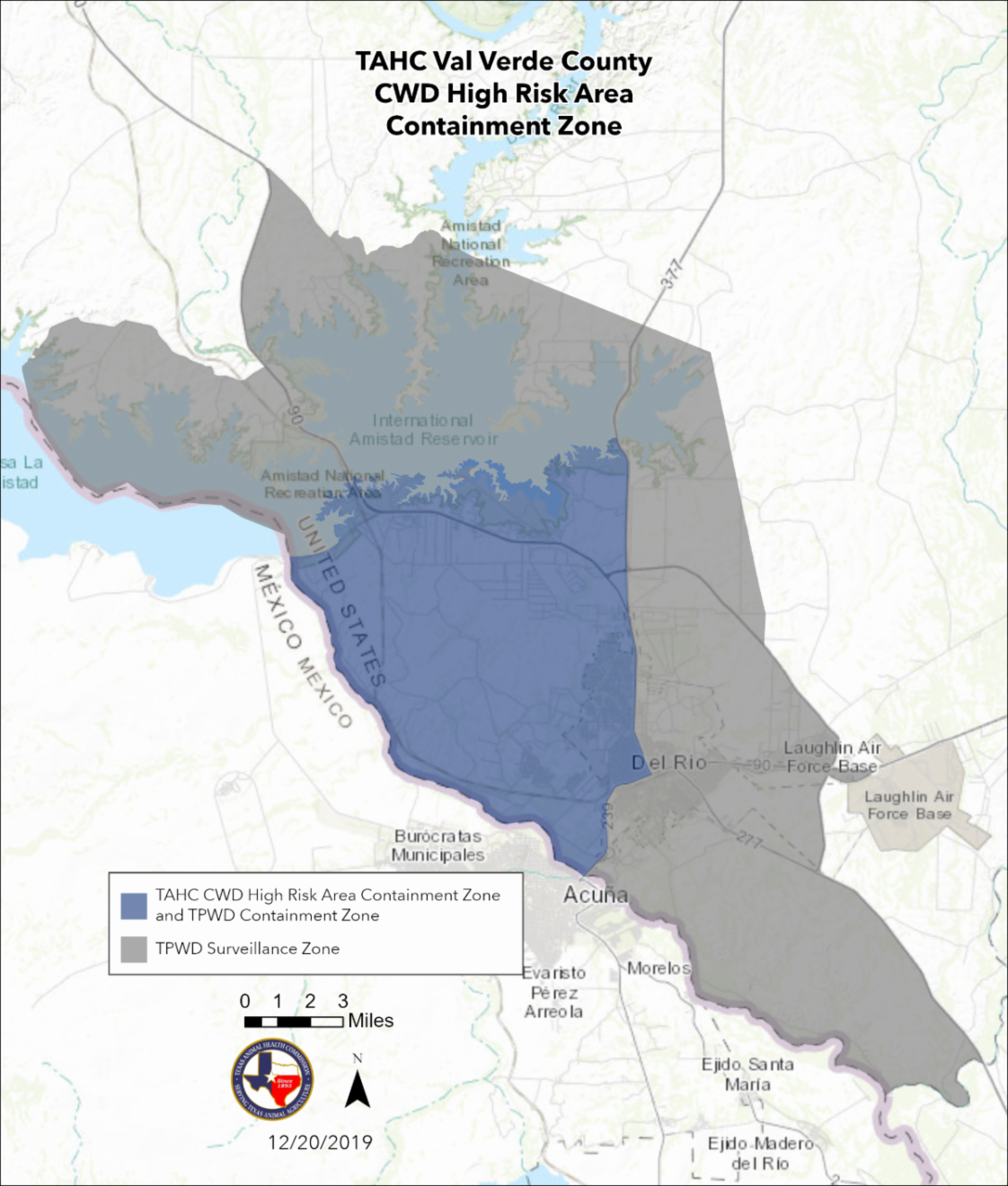Chronic Wasting Disease Containment Zone Established in Texas
Texas Parks and Wildlife has confirmed that chronic wasting disease (CWD) has been detected in a free-ranging, five ½-year-old white-tailed doe between Del Rio and Amistad Reservoir, making it the first confirmed case of the disease in Val Verde County. In response to the confirmation of CWD, the Texas Animal Health Commission (TAHC) Executive Director established a CWD High-Risk Area Containment Zone (CZ) in a portion of the affected area on December 20, 2019.
Val Verde County Containment Zone
“Because eradication is thought to be impossible once CWD becomes established in a population, it is imperative that we work with other agencies, landowners and hunters to contain this disease within a limited geographic area and prevent it from spreading further among Texas deer populations,” said Dr. Bob Dittmar, TPWD’s Wildlife Veterinarian. “This containment strategy is particularly urgent considering this detection happened in the middle of the general deer season.”
“Though CWD has not been discovered in non-native or ‘exotic’ susceptible species in Val Verde County, we believe the recent detection creates a high risk for exotic species to be exposed to or develop CWD in that area,” said Dr. Andy Schwartz, TAHC Executive Director, and State Veterinarian. “By establishing a Containment Zone alongside our partners at Texas Parks and Wildlife Department (TPWD), we hope this will limit the spread of CWD and allow us to better understand the distribution and prevalence of the disease in this area.”
Exotic CWD susceptible species include North American elk or wapiti, black-tailed deer, red deer, reindeer, Sika deer, moose, and any associated subspecies and hybrids.
The Executive Director Order declares that portion of the state lying within the boundaries of a line beginning in Val Verde County at the International Bridge and proceeding northeast along Spur 239 to U.S. 90; thence north along U.S. 90 to the intersection of U.S. 277/377, thence northerly along U.S. 277/377 to the U.S. 277/377 bridge at Lake Amistad (29.496183°, -100.913355°), thence west along the southern shoreline of Lake Amistad to International boundary at Lake Amistad dam, thence south along the Rio Grande River to the International Bridge on Spur 239 to be a CWD High-Risk Area Containment Zone (from now on referred to as CZ).
What is CWD?
CWD among cervids (deer species) is a progressive, fatal neurological disease that commonly results in altered behavior as a result of microscopic changes made to the brain of affected animals. An animal may carry the disease for years without outward indication, but in the later stages, signs may include listlessness, lowering of the head, weight loss, repetitive walking in set patterns, and a lack of responsiveness. To date, there is no evidence that CWD poses a risk to humans or non-cervids. However, as a precaution, the U.S. Centers for Disease Control and the World Health Organization recommend not to consume meat from infected animals.
Hunters are encouraged to report any “sick looking” deer, elk, or other CWD susceptible species while hunting in any CWD zone to TPWD. Contact information for the CWD zone check stations is found within the CWD section of the current Outdoor Annual and associated smart device application. To report a “sick looking” deer outside of a CWD zone, contact a TPWD wildlife biologist or Texas Game Warden. TPWD will continue to collect samples from all hunted properties located within the containment and surveillance zone as well as roadkills. The TAHC and TPWD are seeking as many additional samples for testing as can obtain to get a better handle on the geographic extent and prevalence of the disease in this area.
What You Need to Know
The following requirements apply to all exotic CWD susceptible species within the CZ:
- Live susceptible species may not be moved from the CZ.
- Live susceptible species may only be released within high fenced premises and must have official identification.
- All hunter-harvested susceptible species, 16 months of age or older, must be CWD tested by a certified individual or moved directly to a TPWD Check Station in Val Verde County for CWD testing within 48 hours of harvest. The test results must be provided to the TAHC within 30 days of receiving the test results.
- Before moving out of the CZ, all susceptible species carcasses, or carcass parts, must undergo approved CWD testing within 48 hours of harvest and meet the requirements of 4 TAC §40.6(e) related to carcass movement restrictions.
TPWD established a CWD Surveillance and Containment Zone in the affected area on December 19, 2019, which restricts movement and mandates testing requirements for native species.
For more information, visit ValVerde CWD.


